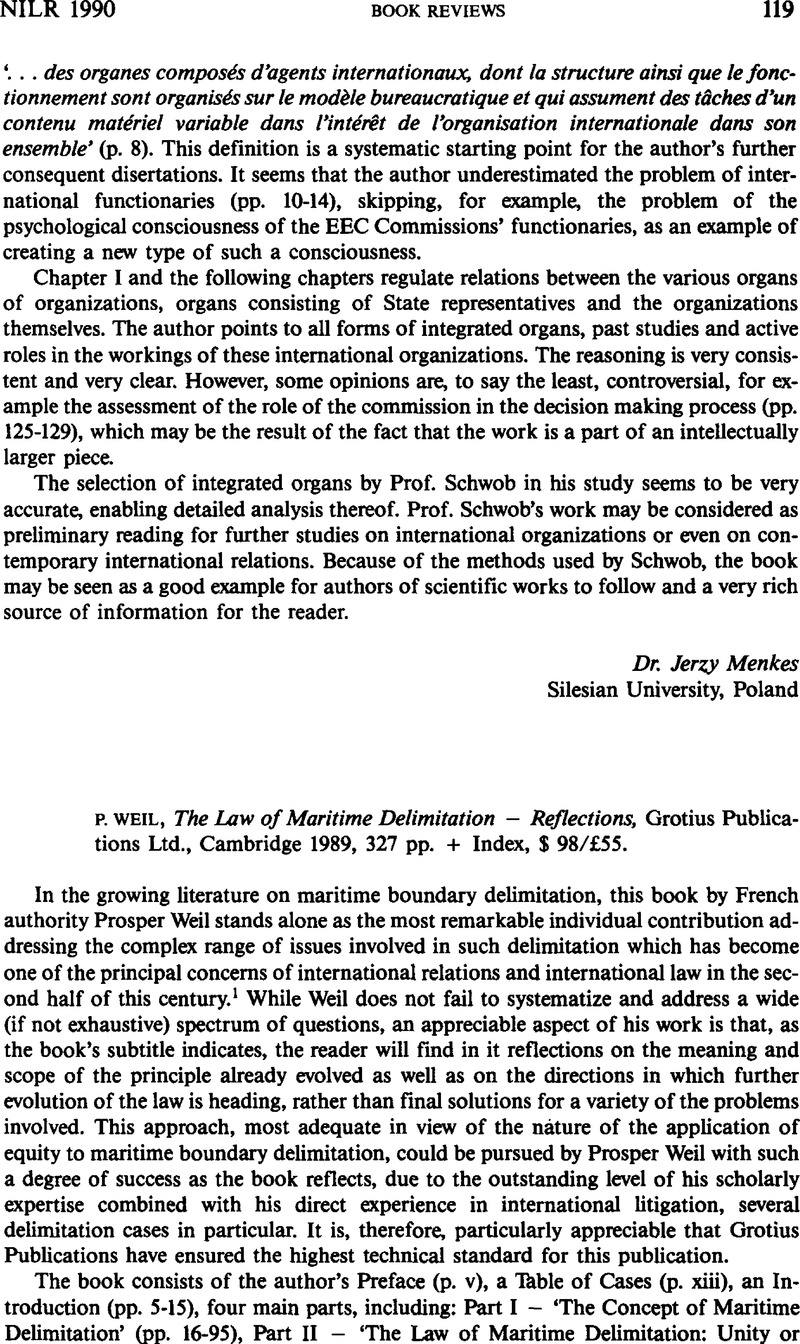Article contents
P. Weil, The Law of Maritime Delimitation – Reflections, Grotius Publications Ltd., Cambridge1989, 327 pp. + Index, $ 98/£55.
Published online by Cambridge University Press: 21 May 2009
Abstract

- Type
- Book Reviews
- Information
- Copyright
- Copyright © T.M.C. Asser Press 1990
References
1. The book is a translation by MsMacGlashan, Maureen, the Assistant Director of the Research Centre for International Law at the University of Cambridge, of the original French version, Perspectives du Droit de la Délimitation Maritime (Editions Pedone, A., Paris 1988)Google Scholar. Prosper Weil, Professor of International Law at the University of Paris, and Director of the Institut des Hautes Études Internationales of Paris, belongs to a rather small group of French authorities whose works are translated into English. Note his well-known article, ‘Towards Relative Normativity in International Law’, 77 AJIL (1983) pp. 413–442CrossRefGoogle Scholar, which was originally published in 86 RGDI (1982) p. 5Google Scholar.
2. For an excellent general appraisal, see Rosenne, Shabtai, ‘The Position of the International Court of Justice on the Foundations of the Principle of Equity in International Law’, in Forty Years International Court of Justice: Jurisdiction, Equity and Equality, Bloed, A. and van Dijk, P., eds. (1988) pp. 85–108Google Scholar. Cf., Vicuna, F. Orrego, The Exclusive Economic Zone: Regime and Legal Nature in International Law (1989) Chap. 7Google Scholar, emphasizing the lack of a systematic analysis of the contents and legal implications of State treaty practice. Note that Prosper Weil is one of the experts involved in the Maritime Boundary Project undertaken by the American Society of International Law with a view to examining all existing boundary agreements.
3. See Jennings, R.Y., ‘The Principles Governing Marine Boundaries’, in Festschrift für Karl Doehring (1989) pp. 397, 406Google Scholar.
4. Cf., Schachter, O., International Law in Theory and Practice, General Course in Public International Law (1985) pp. 271–274Google Scholar, arguing that the coastal State's entitlement is based on geographical contiguity (continuity).
5. Note especially the technical contributions to maritime delimitation by Commander Beazley, P.B., e.g., his Maritime Limits and Baselines: A Guide to their Delimitation, Hydrographic Society Sepcial Publication, No. 2, 2nd edn. (1978)Google Scholar; ‘Half-Effect Applied to Equidistance Lines’, 56 International Hydrographic Review (1979) pp. 153–160Google Scholar; ‘Maritime Boundaries: A Geographical and technical Perspective’, in the Law of the Sea Institute's The UN Convention on the Law of the Sea: Impact and Implementation (1987) pp. 319–339.
6. Cf., the Report on the Relationship between the Exclusive Economic Zone and the Continental Shelf, prepared by Nelson, L.D.M., Rapporteur of the Committee on the Exclusive Economic Zone, in Report of the Sixty-Second Conference of the International Law Association, Held at Seoul, 24–30 August 1986(1987) pp. 328–343Google Scholar; and Kwiatkowska, B., The 200 Mile Exclusive Economic Zone in the New Law of the Sea (1989) pp. 6–19Google Scholar.
7. In this context, Weil observes that: ‘If, as the Court seems to suggest, equidistance as a first step is justified when it is a matter of delimiting multi-purpose jurisdiction such as the territorial sea, then it must be the more so for the delimitation of that other multi-purpose jurisdiction, the 200 mile zone, which nowadays encompasses the continental shelf’ (p. 140).
- 1
- Cited by


